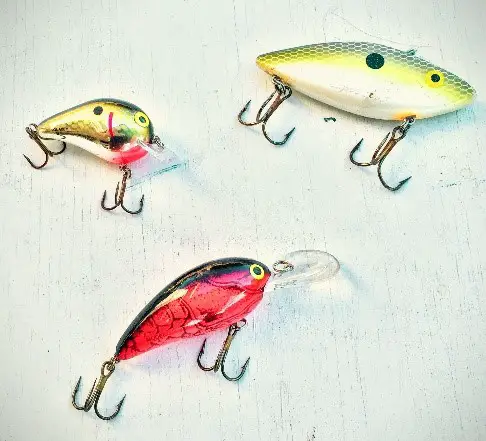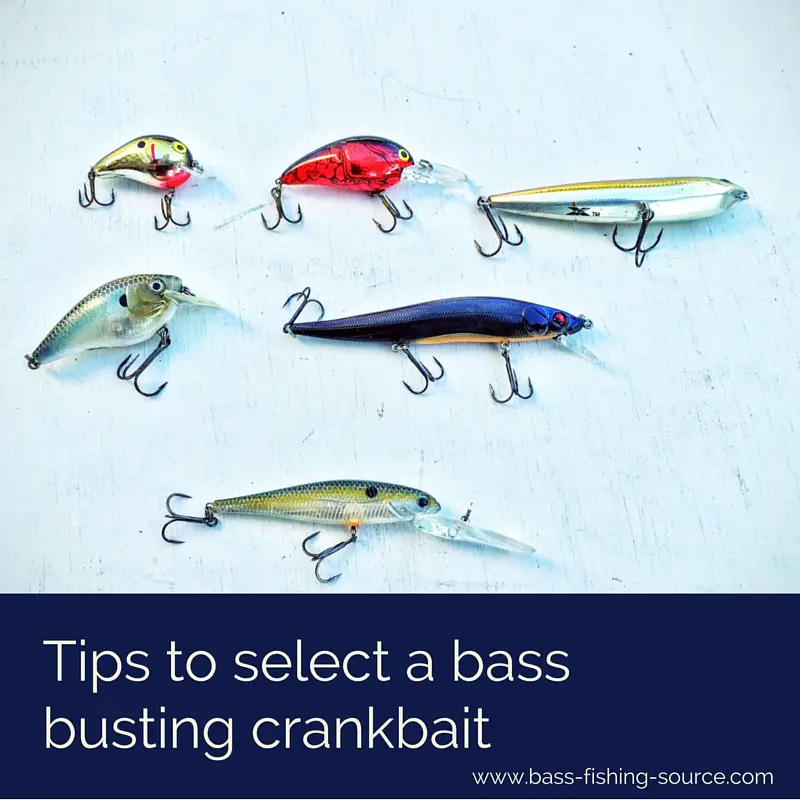the guide to Selecting a Bass Busting Crankbait.
When it comes to bass fishing with crankbaits, many anglers have questions about what type they should use. And it's a very valid question because the decision will more than likely affect the amount of bass you catch.
But how do you decide?
Jump To:
With so many different sizes, colors and shapes from several different lure manufactures, deciding on which crankbait to tie on your line can be tough. Here are some things to consider to help narrow down your choice.
Crankbait Action
The action of the crankbait you choose will play a role in the amount of bass you catch. The action or wobble of the lure can vary by the shape and position of the lip.
You will find crankbait lures with rounded lips and some with square lips, each producing a different kind of movement in the water. The position or angle of the lip from the center line of the lure also affects the movement of the lure during retrieve. The straighter or more inline the lip is with the center of the lure the more wobble the lure will produce.
A popular technique is to manually adjust the movement of a crankbait. Some anglers file the lip of their lure to make it respond in a way that has produced the most results for them. Of course this comes with experience in using these lures over time.
Sometimes to entice an aggressive strike from that lunker bass you'll want an erratic moving crank that is just going crazy on the end of your line. A more squared off, centered lip or bill will get you that type of action.
If the read you are getting from the fish is opposite, like on a cooler winter morning when a bass will not want to expend much energy, you may want a more subtle, easygoing crankbait to provoke a strike from a bass looking for an easy target. This is when you will want to choose a crank with a rounded lip that is angled down from the center line of the lure.
The key here is to know what your lure is doing underwater. Find some clear water and try your lures out before you fish with them. Learn what they do upon retrieval. Retrieve them at different speeds to see how this changes the action of the lure. See how quickly they start diving and how far they actually dive. Learn how they work and you will have taken another step in knowing which crankbait lures to use.
Seasonal Conditions
Another factor in deciding on the best crankbait lures for your next fishing trip is the time of year. Well really what we are talking about here is knowing how the bass react to the current conditions.
crankbaits in summer
If you are fishing on a hot, summer day then you must understand that during the morning hours you may be able to find bass near the surface, in the shallows but once you get past those early hours of the day the bass will retreat to deeper waters to escape the heat of the sun. These situations will call for some deep water cranks.
Deep diving crankbaits can be identified by their larger "bill" or "lip". The larger the lip the deeper the dive. Some of these lures are made to go several feet deep so you can reach deep structure and bang them around submerged timber and rocks to provoke a strike.
Crankbaits in spring
For spring or fall bass fishing, you can use shallow diving or lipless crankbaits. These will work just below the surface of the water to entice a strike from bass that will spend most of their time during these months closer to the surface than they would during summer.
Adjusting for Size
The size of the crankbait you use should be appropriate for the size of the bass you are going after. If you are fishing for White Bass then you should be using a smaller size lure based on the fact that these fish average in size from 10 - 12 inches and no more than 2 pounds.
On the other hand, going after Largemouth bass or peacock bass will require much larger lures. Keep in mind if you want to catch bigger fish then you should use bigger lures but know what is in the water you are fishing and don't go so big with your crankbait that you risk not getting any strikes. Is the lake or river known for big bass? Is it likely that you can pull a hawg weighing in the teens or bigger?
Or does the history of that body of water show no significant catches? If so then lighten up a little to improve your chances of getting the strike. As you fish, if you feel the potential for bigger better bass you can always tie on a larger one on and "test the waters".
True Colors....?
There are many different view points on how to choose a color of crankbait to have the best chance of catching that lunker.
The general rule of thumb here, as with choosing and using any lure, is to use what appears natural to the fish. What type of bait fish naturally occur in the body of water you are fishing? Find that out and find crankbaits similar in color to add to your arsenal.
So already we arrive at our first subjective point.
The flip side of this is the argument from some that you want to use something that stands out, something bright and flashy to stimulate interest and provoke that strike. And this has also been proven to work. But once again it may boil down to the temperament of the bass in the body of water you are fishing.
Are these fish aggressive and lively? If so you will probably have success with the brightly colored, flashy cranks. If not then you may wind up spooking a careful, lethargic bass with something so unnatural looking.
Again knowing your surroundings and knowing how the current conditions affect the temperament of the bass is going to help you decide what route to go.
water clarity effects color selection
Another thing to take into consideration is the clarity of the water.
Is your fishing spot dark and murky or is pretty much clear?
When conditions are clear you can tone it down a bit as your lure will be easier to see in the clear conditions. If your are fishing less visible, murky water then is the time to bring out colors that can cut through the murkiness to catch the eye of that hungry bass.
Depth is another factor that may influence your color choice. The deeper your crank is running, the less light there is to make it noticeable. So again your brighter, florescent and neon colors might come in handy here. Now if you decide to really plunge down into the depths, then color might actually not be a factor at all as nothing can be seen if you get to far away from the surface and any light being able to shine onto the lure.
You may be able to make out a pattern here that we could make into another general rule. The clearer your situation, be it water, weather or depth. the more neutral or natural colors you can go with. The darker the situation in any of those same areas the more you will want to lean towards brighter lures, again taking into consideration the "attitude" of the bass.
wrapping in it up
These are some of the things to consider when trying to decide on which Crankbait lures to use. Don't over complicate things. Take some of this info, choose yourself 6 - 8 lures to take with you and see what the bass like. They'll let you know. With experience you'll narrow it down to a few productive lures in no time at all.
Click to shop for crankbaits at Amazon.com
Goodluck and Happy Bass Fishing!
Make sure you check out our Bass Fishing Lures page for more info on other great lures.
Go from Crankbait Lures to the Bass-Fishing-Source home page.


New! Comments
Let us know what you think! Leave us a comment in the box below.